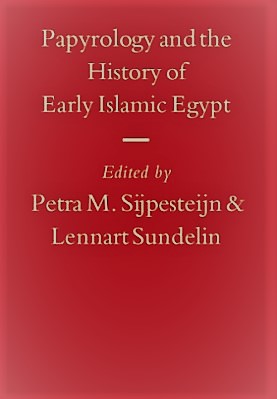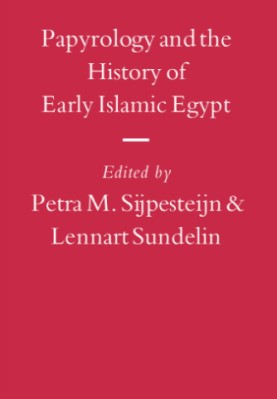
| Papyrology And The History Of Early Islamic Egypt |
| Lennart Sundelin |
| 295 |
| |
| PDF Direct Download Link |
| Click for Hard Copy from Amazon |
PAPYROLOGY AND THE HISTORY OF EARLY ISLAMIC EGYPT – Book Sample
INTRODUCTION: PAPYROLOGY AND THE STUDY OF EARLY ISLAMIC EGYPT
In 1902, when Alfred Butler published his classic study The Arab Conquest of Egypt and the Last Thirty Years of the Roman Dominion, the first fruits of spectacular recent papyrus finds were only just then becom-ing available to historians. Starting with documents discovered in 1877 on the site of ancient Arsinoe, just outside Madìnat al-Fayyùm, thousands of Greek, Coptic, and Arabic texts were soon being dug up there and elsewhere in the Fayyùm oasis.
Major finds were like-wise made at Ihnàs al-Madìna (Heracleopolis), Bahnasà (Oxyrhynchus), Ashmùnayn (Hermopolis), Kòm Ishqàw (Aphrodito), West Thebes, Aswàn (Syene and Elephantine), and at several other sites in Upper and Middle Egypt.2
Written predominantly on papyrus, but also on parchment, cloth, wood, bone, leather, and broken pieces of pottery (and some of the later documents also on paper), these texts were found in the course of archaeological excavation, clandestine digging by local inhabitants, or simply by accident, often as a result of the expansion of Egyptian agriculture in this period.
From the 1880’s on, editions of texts as well as descriptive catalogs of major collections began appearing with increasing frequency. Butler was already able to consult the first of these and he made several references to the papyri.
For example, in his discussion of the problems posed by the considerable gap between the seventh-century chronicle of John of Nikiou and the much later appearance of Arabic historical writing about the Conquest period, Butler suggested that “there is some hope of bridging the gulf when the immense mass of Fayûm and other papyri comes to be examined.”3 And, later in the book, some documents from the Vienna collection would be used to resolve a question about a name appearing in John’s Chronicle.4
Before the 1870’s, there had been very few papyrus texts avail-able for the study of early Islamic Egypt and the tumultuous decades of Byzantine and Persian rule that preceded the Arab Conquest.
Yet, the potential historical importance of these artifacts had come to the attention of European scholars already by the mid-eighteenth century, particularly after the 1752 discovery of hundreds of papyrus rolls at Herculaneum in Italy. And European travelers to Egypt had been bringing home scraps of ancient texts on papyrus for centuries.
By the early nineteenth century, more were being found in excavations carried out by collectors of Egyptian antiquities. The first Greek papyrus to be edited and published appeared in 1787, then a second in 1813.5 Throughout the nineteenth century there was increasing interest and the pace of publication slowly picked up.
But these early editions of Greek papyri were generally texts stemming from the Ptolemaic or early Roman eras, periods of much greater interest to scholars of that day than later materials. In fact, it often happened that when later documents were found in the course of excavation, they were simply discarded by collectors who were really only interested in classical period texts.
It has been estimated that “many thou-sands” of Byzantine Greek, Coptic, and Arabic documents were lost in this way.6 And, before the late nineteenth century and the rise of Theodor Mommsen’s Altertumswissenschaft, there was limited interest in documents at all, as opposed to literary texts, which were what really interested both scholars and collectors.7
Interestingly, Arabic documentary papyri had been published as early as 1825, when two eighth-century safe conduct passes were edited by the renowned French orientalist A. I. Silvestre de Sacy.8
He would go on to publish two more early Arabic papyri, as well as a re-edition of his first two texts, but it would then be decades before anyone else stepped forward to continue his pioneering work. In general, very little documentary evidence relevant to this period, in any language, would be available before the end of the nineteenth century.
The real contribution of the papyri for the study of late Byzantine and early Islamic Egypt would only come with the publication of documents from those large finds which began to be made in 1877. These included texts written in Arabic, Greek, and Coptic, and even some in Syriac and Middle Persian.
Because the cataloging of document collections remains incomplete, and because papyri continue to be found in Egypt and continue to appear in the hands of antiq-uities dealers or private collectors, it is difficult to say with any pre-cision how many texts have been found in total. Nevertheless, it is clear that a staggering amount of material is available for researchers.
In 1993 the papyrologist Peter van Minnen estimated that 35,000 Greek papyri had already been edited and published.9 In the ten years since, the pace at which new texts have been appearing has only increased.
Although the exact number of Greek documents which date to the late Byzantine and early Islamic period is not known, a considerable percentage of the major late nineteenth cen-tury finds were from this era. In some places, such as at Kòm Ishqàw (Aphrodito) in Middle Egypt, most of the material found was late.
In the case of Arabic documents, it is safe to assume that they all postdate the Conquest. Although the total amount published thus far is considerably less than is the case for Greek papyri, the number of texts awaiting editors is enormous.
The man who dominated Arabic papyrology for much of the twentieth century, Adolf Grohmann, estimated in 1952 that some 50,000 Arabic documents had been found, of which roughly 16,000 were written on papyrus, most of the rest being later documents on paper.10 A little more than forty
To read more about the Papyrology And The History Of Early Islamic Egypt book Click the download button below to get it for free
Report broken link
Support this Website
for websites
